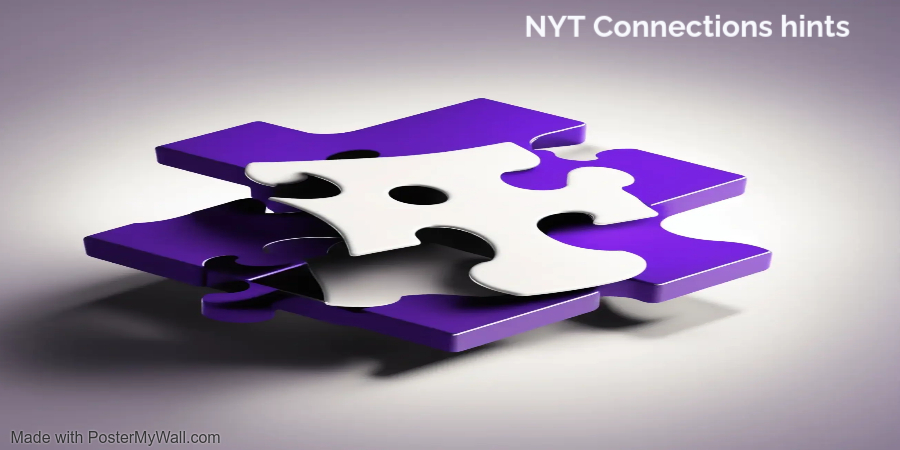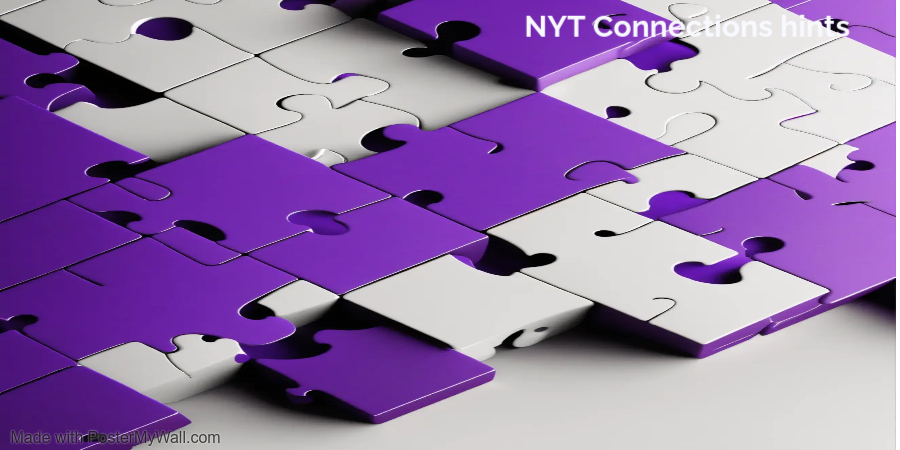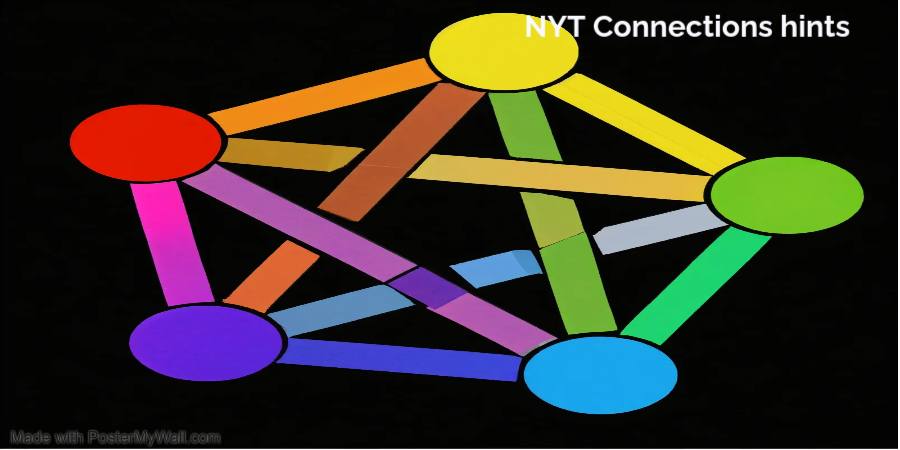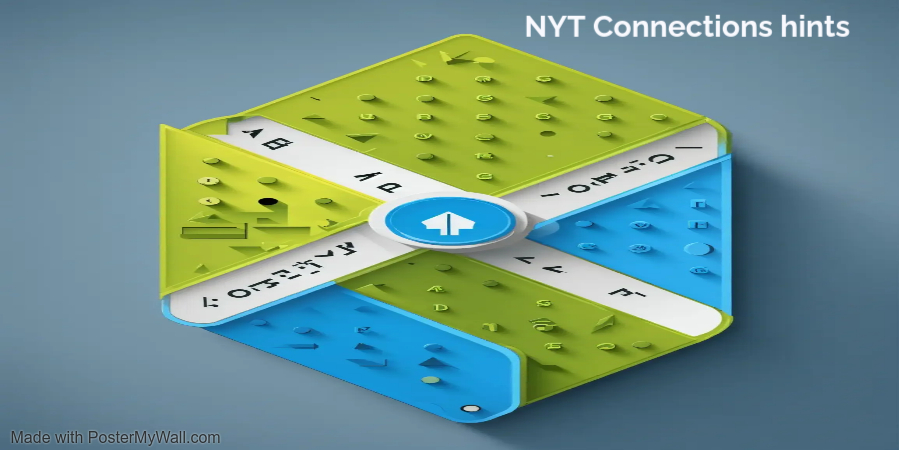Crack the Code with NYT Connections hints Puzzle
Are you a puzzle enthusiast, casual gamer, or someone looking to boost your mental agility? If so, the NYT Connections hints Puzzle might just be your next favorite pastime. This engaging and challenging puzzle has taken the gaming world by storm, and for good reason. In this blog post, we’ll explore the ins and outs of the NYT Connections hints Puzzle, offer expert tips to enhance your solving skills, and provide advanced strategies to help you become a puzzle master. Ready to boost your score? Let’s get started!

What Is the NYT Connections hints Puzzle?
The NYT Connections hints Puzzle is a unique mental challenge that requires players to identify relationships between words in a 4×4 grid. The goal is to find and group words that share a common theme or category. Sounds simple, right? But don’t be fooled—this puzzle can be deceptively tricky.
Overview of the Puzzle’s Format and Rules
Each puzzle presents a 4×4 grid filled with 16 words or phrases. Your task is to identify the connections between these words and group them into four sets of four. The challenge lies in the fact that many words can belong to multiple categories, making it essential to think critically and strategically.NYT Connections hints
Why Has It Become So Popular?
The NYT Connections hints Puzzle gained popularity because it combines elements of logic, language, and general knowledge. It’s a fun way to challenge your brain, and the satisfaction of solving a particularly tough puzzle is incredibly rewarding. Plus, it’s a great way to break up your day and keep your mind sharp.
Why Strategy Matters for NYT Connections hints
While it might be tempting to rush through the puzzle, taking a strategic approach can significantly improve your chances of success.
How Puzzle Complexity Varies
Some puzzles are straightforward, with clear connections between words. Others are more complex, requiring a deeper understanding of language and themes. Recognizing the level of complexity can help you adjust your strategy accordingly.

if you want to learn about fintechzoom click here
Why Rushing Can Lead to Missed Connections
Rushing through the puzzle often leads to missed connections and incorrect groupings. Taking your time to analyze the words and their potential relationships will yield better results. Remember, patience is key!
Understanding the Puzzle’s Structure
To master the NYT Connections hints it’s crucial to understand its structure and mechanics.
Breaking Down the Puzzle Mechanics
Each puzzle consists of a 4×4 grid with 16 words. Your task is to group these words into four sets of four based on shared themes or categories.
How the 4×4 Grid Works
The grid layout allows for multiple possible connections between words. Some connections may be obvious, while others require more thought. Understanding the grid’s structure can help you identify patterns and potential groupings.
Identifying Different Types of Connections
Connections can be based on various criteria, such as synonyms, antonyms, thematic groupings, or even subtle wordplay. Being able to recognize different types of connections will enhance your solving abilities.
The Role of Categories in NYT Connections hints
Categories play a crucial role in the NYT Connections hints . Recognizing and understanding these categories can make all the difference.
How to Recognize Thematic Groupings
Themes can range from simple categories like colors or animals to more complex ones like idioms or cultural references. Training your brain to recognize these groupings quickly will boost your efficiency.
Examples of Popular Puzzle Categories
Common categories include:
- Fruits (e.g., apple, banana, cherry)
- Colors (e.g., red, blue, green)
- Idioms (e.g., break the ice, hit the sack)
Familiarizing yourself with these categories can give you a head start in solving the puzzle.
Expert Tip 1 – Start Broad, Then Narrow Down
Our first expert tip encourages a broad-to-narrow approach when tackling the NYT Connections hints
Why Broad Guesses Are the Best First Step
Starting with broad guesses helps you gain early insights into potential category themes. It’s easier to refine your guesses once you have a general idea of the possible groupings.
Gaining Early Insights into Category Themes
By making broad guesses, you can quickly identify which words seem to fit together. This will help you narrow down the categories and make more educated guesses as you progress.
Avoiding the Pitfalls of Over-Specification
Over-specifying too early can lead to confusion and missed connections. Keep your initial guesses broad and flexible to avoid getting stuck on one particular grouping.
How to Refine Your Approach After the First Guess
Once you’ve made your broad guesses, it’s time to refine your approach.
Moving from Broad Groupings to Specific Matches
After identifying potential categories, start narrowing down your guesses to specific matches. This step involves more critical thinking and analysis.
Using Incorrect Guesses as a Clue for the Future
Don’t be discouraged by incorrect guesses. Instead, use them as valuable clues. Each incorrect guess brings you closer to the correct solution by eliminating possibilities.
Expert Tip 2 – Look for Synonyms and Related Terms
Our second expert tip focuses on the importance of linguistic connections.
The Importance of Linguistic Connections
Linguistic connections, such as synonyms and related terms, can significantly aid in solving the puzzle. These connections are often less obvious but can unlock the puzzle when recognized.
Why Synonyms and Related Concepts Can Unlock the Puzzle
Synonyms and related terms can reveal hidden connections between words. Recognizing these relationships allows you to group words more effectively.
Recognizing Obvious vs. Subtle Word Relationships
Some word relationships are straightforward, while others are more subtle. Training your brain to recognize both types will improve your puzzle-solving skills.
Using Synonyms to Group Words Effectively
Synonyms are a powerful tool in theNYT Connections hints . Here’s how to use them effectively.

Practical Examples of Synonym-Based Categories in Past Puzzles
For example, a puzzle might include words like “happy,” “joyful,” “content,” and “pleased.” Recognizing these as synonyms allows you to group them together.
Common Pitfalls to Avoid When Using Synonyms
Be cautious of words that seem similar but don’t share the same meaning. Double-check your groupings to ensure accuracy.
Expert Tip 3 – Keep Track of Process of Elimination
Our third expert tip emphasizes the importance of the process of elimination.
How Process of Elimination Works in NYT Connections hints
The process of elimination involves systematically removing incorrect choices to narrow down the correct groupings.
Why Eliminating Incorrect Choices is Key to Success
Eliminating incorrect choices helps you focus on the remaining possibilities, increasing your chances of finding the correct connections.
Techniques for Tracking What’s Left on the Grid
Keep track of your guesses and eliminations to stay organized. This can be done through notes or mental tracking.
Refining the Process of Elimination Method
Refining your process of elimination method will enhance your efficiency and accuracy.
Using Previous Puzzle Attempts to Inform Future Guesses
Learn from your past puzzle attempts. Recognizing patterns and techniques that worked before can inform your future guesses.
How to Stay Organized with Your Guesses
Maintain a clear and organized approach to your guesses. This helps avoid confusion and ensures you’re making informed decisions.
Expert Tip 4 – Use Cultural Knowledge to Your Advantage
Leverage your cultural knowledge to solve puzzles more effectively.
Why General Knowledge Helps with NYT Connections hints
General knowledge, including pop culture, history, and current events, can provide valuable clues for solving puzzles.
How Pop Culture, History, and Current Events Play a Role
Puzzles often draw on cultural references. Being well-versed in these areas can give you an edge in identifying connections.
Categories that Frequently Draw on Cultural References
Categories like movies, books, historical events, and famous personalities often appear in puzzles. Expanding your knowledge in these areas can be beneficial.
Leveraging Personal Interests to Solve Puzzles Faster
Your personal interests can play a significant role in puzzle-solving.
Why Knowing Specific Niche Topics Can Give You an Edge
If you have a particular interest or hobby, it can give you an advantage in certain puzzles. Use your niche knowledge to identify connections others might miss.
How to Expand Your Knowledge Base for Future Puzzles
Continuously expand your knowledge base by exploring new topics and staying curious. This will make you a more versatile puzzle solver.

Expert Tip 5 – Don’t Overthink It
Sometimes, simplicity is the key to success.
Why Simplicity Can Sometimes Be the Key
Overcomplicating connections can lead to confusion. Trusting your instincts and keeping things simple can often result in faster solutions.
The Danger of Overcomplicating Connections
Overthinking can lead to missed connections and frustration. Keep your approach straightforward to avoid unnecessary complications.
How Trusting Your Instincts Can Lead to Faster Solutions
Your instincts are valuable. Trusting them can help you identify connections more quickly and accurately.
Tips to Avoid Overthinking Common Puzzle Categories
Avoid overthinking by following these simple tips.
How Overanalyzing Word Meanings Can Lead You Astray
Overanalyzing word meanings can lead to incorrect groupings. Stick to the basics and trust your initial impressions.
Examples of Simple Solutions That Surprised Players
Many players have been surprised by how simple the solutions to complex puzzles can be. Keep this in mind to avoid overcomplicating your approach.
Advanced Strategies for Mastering NYT Connections hints
For those looking to take their puzzle-solving skills to the next level, here are some advanced strategies.
How to Spot Trick Connections
Trick connections are designed to throw you off. Here’s how to spot them.
Understanding Red Herrings in Puzzle Design
Red herrings are words included to mislead you. Being aware of this tactic can help you avoid falling into their trap.
Why Certain Words Are Included to Throw You Off
Puzzle designers often include words to create confusion. Recognizing this can help you stay focused on finding the correct connections.
Timing Strategies: How Fast Should You Solve?
Timing is an important factor in puzzle-solving.
Why Some Players Benefit from Taking Their Time
Taking your time allows for more careful analysis and fewer mistakes. It’s okay to slow down and think things through.
When Speed Matters for Puzzle Solving
In some cases, speed can be beneficial. Practice solving puzzles quickly to improve your overall efficiency.
Why Playing with Others Can Sharpen Your Skills
Playing with others can provide valuable insights and improve your skills.
The Value of Teamwork in Solving Connections Puzzles
Teamwork allows for different perspectives and ideas. Collaborating with others can lead to faster and more accurate solutions.
Group Dynamics That Can Help or Hinder Your Progress
Group dynamics can either help or hinder your progress. Find a balance that works for everyone involved.
Frequently Asked Questions (FAQs)
Here are some common questions about the NYT Connections hints
What Are Some Common Mistakes Beginners Make in NYT Connections?
Beginners often rush and overlook connections. Taking your time and practicing regularly can help avoid these mistakes.
How Often Does the Puzzle Update and How Can I Improve Between Puzzles?
The puzzle updates regularly. Improving your skills involves continuous practice and learning from your mistakes.
What Are the Most Difficult Types of Connections?
The most difficult connections are often those based on subtle wordplay or obscure references. Expanding your knowledge base can help tackle these challenges.
Are There Tools or Resources to Help Practice for NYT Connections hints ?
Yes, there are various tools and resources available online. Practice puzzles and join puzzle-solving communities to improve your skills.
Can You Use External References or Is It Cheating?
Using external references is generally not considered cheating, but it’s best to rely on your own knowledge and skills for a more rewarding experience.
Conclusion
Mastering the NYT Connections hints takes time, practice, and strategic thinking. By following these expert tips and continuously challenging yourself, you’ll see significant improvements in your puzzle-solving abilities. Remember, persistence is key, and every puzzle you solve sharpens your critical thinking skills. Happy puzzling!
Mastering the NYT Connections hints takes time, practice, and strategic thinking. By following these expert tips and continuously challenging yourself, you’ll see significant improvements in your puzzle-solving abilities. Remember, persistence is key, and every puzzle you solve sharpens your critical thinking skills. Happy puzzling!


